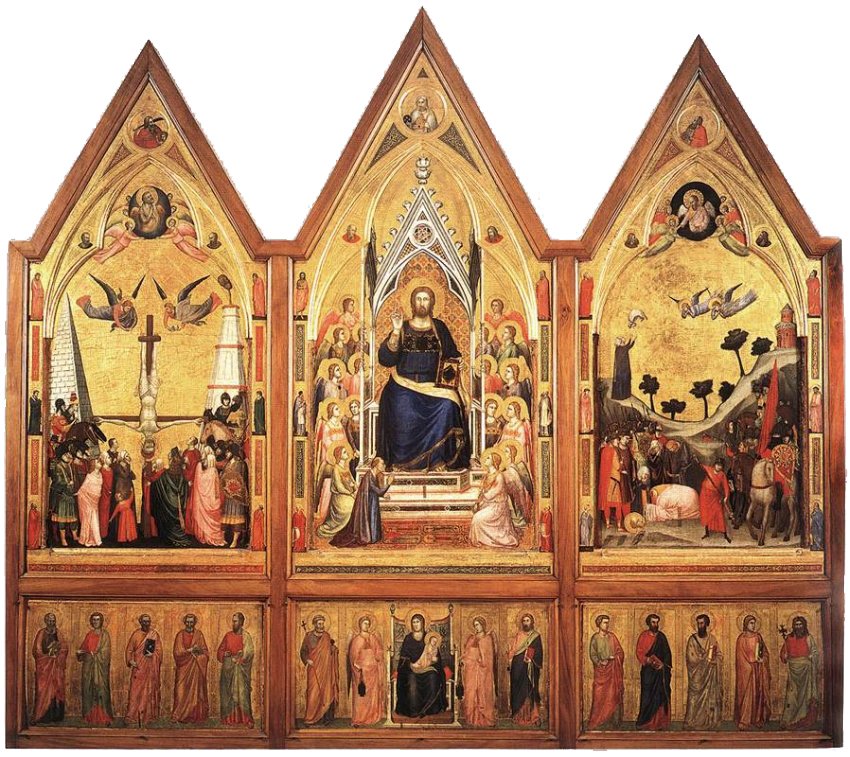The Stefaneschi Triptych is a stunning altarpiece created by Giotto di Bondone, a master artist of the Italian Gothic period.
This remarkable work was commissioned by Cardinal Jacopo Stefaneschi for the high altar of St. Peter’s Basilica and is considered one of Giotto’s most significant contributions to ecclesiastical art.
Renowned for its intricate details, vibrant colors, and innovative storytelling, the Stefaneschi Triptych offers a profound glimpse into the spiritual and artistic sensibilities of the 14th century.
About Giotto
Giotto di Bondone (1267–1337) was a pivotal figure in Western art, credited with ushering in the transition from Byzantine to Renaissance art. Born in Tuscany, Giotto revolutionized painting by introducing naturalism and three-dimensionality, moving away from the flat, stylized figures of his predecessors.

His innovative use of perspective, emotional expression, and realistic settings established a foundation for the flourishing of Renaissance art. Giotto’s legacy is evident in works such as the Scrovegni Chapel frescoes, which continue to inspire admiration for their depth and humanity. His role as an architect and painter for the Vatican further cemented his status as a transformative artist of his time.
About the Painting
The Stefaneschi Triptych, painted between 1320 and 1330, is a double-sided altarpiece that originally adorned the high altar of Old St. Peter’s Basilica. The triptych features richly detailed panels depicting scenes from the lives of Christ and Saint Peter, alongside portraits of saints and angels.
On one side, Christ is enthroned in majesty, surrounded by angels and saints, symbolizing his divine authority. The other side presents Saint Peter enthroned, reflecting the importance of the saint to the Church and his role as the first pope.

Giotto’s mastery is evident in the triptych’s intricate details, such as the expressive faces of the figures, the delicate rendering of the golden backgrounds, and the meticulous attention to texture and color. The altarpiece’s design emphasizes symmetry and harmony, while its narrative clarity invites viewers to engage deeply with its spiritual themes. The Stefaneschi Triptych is also notable for its inscription, which highlights Cardinal Stefaneschi’s role as a patron and emphasizes the connection between art and devotion.
History and Significance
Commissioned by Cardinal Stefaneschi, the triptych reflects the opulence and spiritual aspirations of the medieval Church. Its dual-sided design allowed it to be admired by both clergy and laity, serving as a focal point for worship and contemplation.
Giotto’s innovative approach to composition and naturalism marked a departure from the static forms of Byzantine art, making the Stefaneschi Triptych a forerunner of the Renaissance. This masterpiece remains a testament to Giotto’s visionary artistry and the Church’s role as a patron of the arts.
Where to See It
Today, the Stefaneschi Triptych is housed in the Pinacoteca Vaticana, part of the Vatican Museums. Visitors can admire its exquisite craftsmanship and vibrant colors, which have been preserved through centuries.
The triptych occupies a prominent place in the gallery, inviting viewers to reflect on its spiritual and historical significance. As one of the most celebrated works of medieval art, the Stefaneschi Triptych is a must-see for those exploring the Vatican Museums’ rich collection.
Visitor Tips
To fully appreciate the Stefaneschi Triptych, take your time to examine both sides of the altarpiece, noting the intricate details and symbolism embedded in each panel. Consider using an audio guide or joining a tour to gain deeper insights into Giotto’s techniques and the historical context of the triptych. This extraordinary work is an enduring testament to the power of art to inspire faith and devotion.
More to Discover at Vatican Museums:
- The Tranquil Square Garden of the Vatican Museums
- The Dramatic Masterpiece: Caravaggio’s The Deposition

